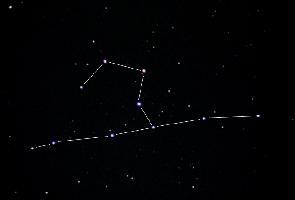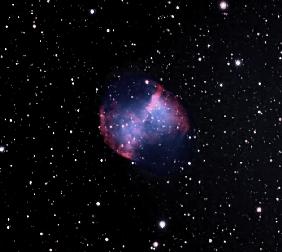Vulpecula
Brocchi's Cluster
M27 - The Dumbell Nebula
Vulpecula is a small constellation that lies between Cygnus and Lyra to the north and Delphinus, Sagitta and Aquila to the south. It has no bright stars but does, however, contain two A-List objects! It comes highest in the sky during July, August and September.
Brocchi's Cluster - The Coathanger Asterism E B L
Brocchi's Cluster is commonly called the 'Coathanger' because that is exactly what it looks like! Seen upside-down with binoculars from the northern hemisphere - the right way up for southern observers - it is best found by sweeping across the milky way from the bright star Altair, in Aquila, one third of the way towards Vega, in Lyra. It should be easily spotted against a darker region of the Milky Way called the Cygnus Rift. It is a grouping of around 40 stars, but only 6 or so of the brighter ones have a common motion through space - the definition of the stars forming a cluster - so it might better be termed an 'asterism' - a chance pattern of stars. It subtends one degree across, so binoculars or a telescope at low power will show it best. There is a very nice colour contrast between two red giant stars forming part of the handle and the whiter stars of the 'bar'.
position: 19h 25.4m +20deg 11min
M27 - The Dumbell Nebula Planetary Nebula B M H
In 1762 Charles Messier discovered the 27th object in his catalogue, describing it as an oval nebula without stars. Later John Herschel gave it its common name, the Dumbell Nebula. It was the first planetary nebula to be discovered and is the remnant of a giant star that exploded at the end of its life leaving a cloud of dust and gas surrounding the dying ember of its core ? a so called white dwarf star about the size of the Earth. This white dwarf is still extremely hot, about 85,000K, and so is emitting ultraviolet light which is exciting the surrounding gas shell and making it glow. As with all nebulous objects, it is best searched for in dark and transparent skies. The easiest way to locate it is to first find Gamma Sagitta, the 3.5 magnitude star at the head of the tiny flattened triangle making up the 'arrow' of Sagitta. This lies 10 degrees directly north of Altair in Aquila. If Gamma Sagitta is now placed at the bottom of a binocular or finder field of view, M27, which is 3 degrees north, should be visible towards the top. (Southern observers put Gamma Sagitta at the top and look towards the bottom.) The nebula is 8 by 6 arc minutes in angular size and 7.4 in magnitude so it should be picked up as a bright spot in 8x40 or 10x50 binoculars. A telescope at medium power will show it as an elongated nebula, rather like an apple core in shape, and an 8-inch (200mm) telescope or larger may well show the 13.5 magnitude central white dwarf star. Its distance is not well known, perhaps 1,250 light years, and measurements of its rate of expansion, some 6.8 arc seconds per century, gives an estimated age of three to four thousand years.
Position: 19:59:36.340 +22:43:16.09





